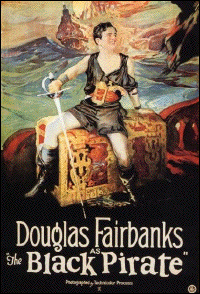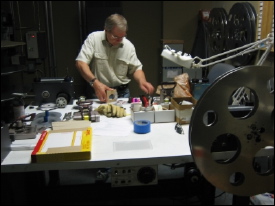 | | The swashbuckling Douglas Fairbanks starred in one of the first hit movies made in Technicolor. |
Introduction
The story of how new technologies enabled Hollywood to become America’s dominant culture factory, and remain in that role for more than a century, hasn’t been told before. It’s a story that’s relevant not only to avid movie-goers and industry insiders, but to businesspeople, artists, and inventors working in any field who are interested in the relationship between innovation and the status quo. How does innovation ever prevail when just about everyone working in a given field would prefer that things remain the same? (The introduction is included in the free preview of the book.)
Chapter 1: Inventing the Movies
Thomas Edison and the Kinetoscope; the Lumière brothers; George Eastman and Kodak; the nickelodeon explosion; D.W. Griffith; the Motion Picture Patents Company; and the emergence of the first movie moguls. (Chapter 1 is included in the free preview of the book.)
Kodak founder George Eastman: “I wouldn’t give a dime for all the possibilities of [movies with sound]. The public will never accept it.”
Chapter 2: ‘Who the Hell Wants to Hear Actors Talk?’
The Warner brothers, Don Juan and The Jazz Singer; Irving Thalberg; Frank Capra and Columbia chief Harry Cohn; Gary Cooper; Douglas Fairbanks, Mary Pickford, and United Artists.
Silent film actor Ronald Colman: “...I am not sympathetic to this ‘sound business.’ I feel, as many do, that this is a mechanical resource, that it is a retrogressive and temporary digression insofar as it affects the art of motion picture acting — in short, that it does not properly belong to my particular work (of which naturally I must be the best judge).”
Chapter 3: How Television Led to Smell-O-Vision
Early attempts at color; Herb Kalmus and the development of Technicolor; The Black Pirate; Gone with the Wind; Walt Disney’s willingness to experiment; the studios confront television; a New Jersey entrepreneur invents (and tries to patent) the drive-in; the early days of pay-TV; “theater television”; Bwana Devil and the 3-D boomlet of the 1950s; Cinerama and the ever-widening screen; Smell-O-Vision and AromaRama; and the great showman William Castle.
“First They Moved (1895)! Then They Talked (1927)! Now They Smell!” — advertisement for 1960’s Scent of Mystery, released in Smell-O-Rama
Chapter 4: Befriending the Boston Strangler
Bing Crosby and the development of video recording; Andre Blay and the birth of the home video industry; how two Hollywood studios took Sony’s Betamax to the Supreme Court; Jack Valenti and the MPAA; Lew Wasserman and Sid Sheinberg of Universal; Akio Morita and Harvey Schein of Sony; Tip O’Neill; Mr. Rogers; Sumner Redstone; Pinocchio; and Top Gun.
“I don’t have any question whatsoever that we were legally right. None.” — former Universal exec Sid Sheinberg, interviewed in 2007, on Hollywood’s battle against the Betamax
Chapter 5: From Shotguns to Software
The arrival of computer-generated animation and special effects; Poltergeist; Tron; Industrial Light & Magic; Jurassic Park; Doug Trumbull; Forrest Gump; George Lucas; James Cameron; Richard Hollander and Rhythm & Hues; Rob Legato and The Aviator; Jim Rygiel; Richard Chuang and PDI/DreamWorks Animation; Ed Catmull, John Lasseter, Where the Wild Things Are, Disney, Steve Jobs, and Pixar; Hanna-Barbera; Toy Story; Madagascar; and Jeffrey Katzenberg.
Pixar co-founder Ed Catmull, on making Toy Story, the first computer-animated feature film: “...I viewed it as a ten-year project. But it took twenty years.”
Chapter 6: Movie Editors’ Slow Cross-Fade
Iwan Serrurier and the Moviola; Bill Warner, Eric Peters, and the creation of Avid Technology; Steven Cohen and Lost in Yonkers; Francis Ford Coppola; EditDroid; Dean Goodhill and The Fugitive; Richie Marks; Walter Murch, The English Patient and Cold Mountain; James Cameron and Titanic; Final Cut Pro; Michael Kahn and Steven Spielberg.
Avid Technology executive Eric Peters: “There were a number of old editors who vowed that they were never going to use electronic editing. They were like concert pianists who were told that instead of playing on a Steinway, they were going to have to perform on a Moog synthesizer.”
Chapter 7: Digital Cinema Pioneers
Lance Weiler, Stefan Avalos, and The Last Broadcast; Russ Wintner and Cinecomm; Paul Breedlove and Texas Instruments; Phil Barlow, Bob Lambert, Disney, and Tarzan; The Phantom Menace; Miramax and An Ideal Husband; Joerg Agin, Bob Mayson, and Kodak; Bran Ferren; and visionary engineer Albert Abramson.
Albert Abramson, a CBS television engineer who had predicted the arrival of “electronic” movie production and distribution in the 1950s: “I have long ago learned not to project the future, as it has a bad habit of doing whatever it wants to do...”
 | | Even in the early 21st century, as digital cinema began to gain a foothold, most movies still arrive at multiplexes in celluloid form, where projectionists splice them together with the trailers that will screen before them. Shot in 2007. |
Chapter 8: ‘Agreeing on the Weather’
NewCo Digital Cinema; Toy Story 2; Jack Kline and Christie Digital; Technicolor Digital Cinema, Hughes Electronic Cinema, and Boeing Digital Cinema; Bounce; John Fithian and NATO; Attack of the Clones; critics Roger Ebert, Todd McCarthy, and Godfrey Cheshire; Chuck Goldwater, Walt Ordway, and Digital Cinema Initiatives; Loren Nielsen, Conrad Hall, and Road to Perdition; Screenvision, National CineMedia, and digitally-delivered advertising at the multiplex; Arts Alliance, the UK Film Council, and digital cinema in Europe; and Bollywood goes digital.
John Fithian, president of the National Association of Theater Owners, on fans who expressed a preference for digital cinema: “God bless these fans, but they'd scream bloody murder if they had to pay $45 a ticket [to cover theater-owners’ costs of converting to digital projection.]”
Chapter 9: Filming Without Film
Lee Garmes, Donald Morgan, Giuseppe Rotunno, Why, Santee, Julia and Julia and the early days of electronic cameras; “Guardians of the Image”: the American Society of Cinematographers, Victor Kemper, Steven Poster, and Daryn Okada; Larry Thorpe, Sony Electronics, and the CineAlta digital camera used for Attack of the Clones; A brief history of Panavision, from Robert Gottschalk to Bob Beitcher to the Genesis; Dean Semler, Mel Gibson, and the decision to shoot Apocalypto digitally; and Peter Jackson, King Kong, and an experiment with the first camera from Red Digital Cinema.
Cinematographer Tom Ackerman, on film versus digital: “I have no agenda where I want to see [film] disappear. I like the photochemical process, and I’ve spent plenty of hours developing still film in the darkroom. But a lot of my colleagues have been too hidebound, in my opinion. We wax poetic about this stuff, and we allow it to become mythical, when we need to be talking about it as a tool.”
Chapter 10: Coming to Terms with the Net
On the set of 10 Items or Less with Morgan Freeman; Steven Soderbergh, Mark Cuban, and the attempt to release Bubble simultaneously in theaters and on cable TV; Hollywood dips a toe into online distribution with Movielink and CinemaNow; the meteoric rise of YouTube and Netflix; Apple, the iPod, and iTunes; file-sharing sites head to the Supreme Court; Disney, Chicken Little, James Cameron, Avatar, and the second coming of 3-D; and the Blu-ray/HD DVD standards battle. (Chapter 10 is included in the free preview of the book.)
Mark Cuban, on skeptics who were predicting that releasing movies simultaneously to theaters, TV, and DVD would destroy Hollywood: “You can’t find a great business where somebody didn’t say the exact same things at the beginning.”
Afterword: Imagining the Future
A visit to the Sony lot; movies on demand, in any form, on any device; the democratization of filmmaking; the convergence of movies, games, and the Internet; will Hollywood evolve fast enough?
Producer and former studio chief Peter Guber: “When you become the incumbent, you’re wary of change. You want to use the same formula all the time.”
Appendix A
What are the key differences between innovators and people who prefer to preserve the status quo?
Appendix B
What are some of the reasons that people resist new ideas and technologies?
Acknowledgments
A Note on Sources
|













